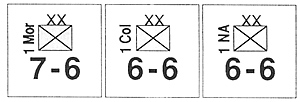 The French in 1939 retained their large colonial areas and the Army relied heavily on these "overseas" troops, as they were called, to fill up the gaps resulting from the wholesale slaughter of French metropolitan soldiers in the Great War. John Astell explained some of the features of these units in the "Players Notes" to FoF, but since they also appear in Western Desert and Torch, and will do so in Second Front, some additional comments may help.
The French in 1939 retained their large colonial areas and the Army relied heavily on these "overseas" troops, as they were called, to fill up the gaps resulting from the wholesale slaughter of French metropolitan soldiers in the Great War. John Astell explained some of the features of these units in the "Players Notes" to FoF, but since they also appear in Western Desert and Torch, and will do so in Second Front, some additional comments may help.
These "First Divisions" are closer to British Empire troops than any other, but not quite the same. For there was one major difference between the French and British Empires. The French defined their territories as being part of France, and did not allow the growth of independent selfgoverning Dominions such as Australia and Canada. They encouraged French (i.e. "white") citizens to settle in large numbers, and considered them citizens of France with their own representatives in the French National Assembly.
This policy remained in effect after 1945, hence the bitterness of the Algerian civil war, and the present-day problems in French Samoa. But enough of politics, the result was that French overseas divisions were of two types.
One was very similar to the Indian Army divisions of the British, composed of regiments of native troops off icered by Frenchmen. Unlike the British, however the French did not "stiffen" the native units by brigading them with "white" regiments. Two of our "First Divisions" are of this type. The French gave their native infantry the title of Tirailleurs, the Napoleonic term for Light Infantry, and distinguished them by the colony of origin.
They also believed (at least in theory) that they could be classified by quality Moroccans the best, Algerians next, and last Tunisians. (The British had a similar theory about their Indian troops, distinguishing between the "hard" northerners like Punjabi, Sikhs and Pathans, and "soft" southerners; like Madrassi and Bengali. Both theories were rubbish, and really reflected who had been the most recent enemies - Pathans for the British and Moroccans for the French.)
Let's look first at the 1 DINA (1re Division D'Intanterie Nord-Africaine). An Active Division stationed in Metropolitan France, its three regiments were the 5 RTM (5th Moroccan), 27 RTA (Algerian) and 28 FITT (Tunisian). This is a typical division, mainly horse-drawn. In May 1940 like many other divisions it lacked antiaircraft guns (it only had 3 20mm!) Its 6-6 rating is only justified by the fact that it retained its original sub-units; many similar divisions were in the process of reorganization when the German attack came.
The second division, the 1 DM (1re Division Marocaine), was made of better stuff. Its three regiments, the 1st, 2nd, and 7th R.T.M., were all Regular units on active service in Morocco at the start of the war - the French had only completed the formal conquest of the colony in the 1920s, and there were still rebels in action. I guess it was the French "North-West Frontier" of the time. These were elite, well officered troops, hence the 7-6 rating, and were rushed to France as fast as possible.
Incidentally, the MAIN concern of the French Navy was to protect the troops convoys from North Africa against possible Italian interception. A nice alternative for Grand Europa? Some players may wonder why, considering the geography of Morocco, the 1 DM is not a mountain division. The reason is that there WERE mountain troops from Morocco, but they were not in Tirailleurs Regiments, but organized into Gourns. Europa players will see them in action in Second Front.
After the fall of France all the "native" regiments were sent bark to North Africa. They formed the mass of the army there, and appear in the OB in Torch. Two of the three regiments of this division fought in France in 1944-45.
First Divisions 1940 France
-
Introduction
1 DIM (1re Division d'Infanterie Motorisee)
1 DLM (1re Division Legere Mecanique)
1 DLC (1re Division Legere de Cavalrie)
1st Divisions: Tirailleurs
1 DIC (1re Division D'Infanterie Coloniale)
1 DCR (1re Division Cuirassee)
Back to Europa Number 9 Table of Contents
Back to Europa List of Issues
Back to MagWeb Master Magazine List
© Copyright 1989 by GR/D
This article appears in MagWeb (Magazine Web) on the Internet World Wide Web. Other military history articles and gaming articles are available at http://www.magweb.com